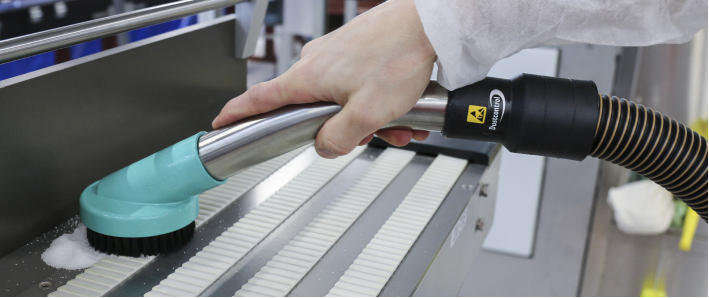The term 'ATEX' refers to atmospheres that are potentially explosive and EU Directive 1999/92/EC covers the health and safety of workers in such environments. All equipment marketed in the EU for use in ATEX areas with "inherent ignition sources" must fulfil the requirements of Directive 2014/34/EU.
In addition, all employers with workplaces where employees may be at risk from explosive atmospheres must have established an explosion protection document in accordance with the mandatory regulations. This should include risk analysis, classification plans, an inventory of flammable liquids, gases and dust, as well as procedures for their safe handling to minimise explosive atmospheres.
Dust explosions occur when combustible dust is mixed with air or oxygen and is ignited. For this to happen, the dust must occur in sufficiently large concentrations. Almost all flammable substances that arise as a result of, or that are used during industrial manufacturing, are combustible and can cause explosions under certain conditions.
Examples of such substances include coal, flour, cereals, wood, cotton and certain plastics. Hazardous dust deposits can be avoided through regular cleaning of any premises used for work or operations.
By using a centralised extraction system designed to extract from an Atex zone and designed according the dust being extracted, businesses can extract dust, fumes, chips, oil spillages and other harmful substances, right at their source. In addition, they can use the system for powerful vacuum cleaning. The result is efficient production where the risk of a dust explosion is reduced to a minimum, or even eliminated. Collected material can either be captured and discharged locally, for example, by recycling it back into the process, or be taken back to the filter unit and discharged away from the main production environment.
Centralised systems, with a fixed pipe run back to a plant area, provide some major advantages to mobile equipment in terms of simple maintenance, delivery of material to a common point, and reduction in the risk of local trip and electrical hazards.
Where the extraction system forms part of the risk assessment, major cost reductions in the purchase of electrical equipment suited to Atex environments can be made where the risks can be lowered due to source extraction and regular cleaning.
Sometimes, a centralised vacuum system will either not suit the building layout or may not be viable. In this case, high efficiency Atex rated mobile equipment can be used as an alternative. These can provide flexibility and the advantage of being able to be deployed quickly as necessary.
Dustcontrol UK has been operating in the food industry for more than 40 years, and has extensive experience in equipment and systems for potentially explosive dust. The firm has recently brought to market its latest range of 'Good For Food' equipment specifically for vacuum cleaning food-contact surfaces and for recycling food grade materials.
Ultimately, by keeping the work environment clean and safe, businesses in the food industry can minimise the risk of dust explosion, maximise production uptime, increase product quality, and benefit from significant cost savings.
 United Kingdom
United Kingdom  Sverige
Sverige  Deutschland
Deutschland  Suomi
Suomi  Austria
Austria  United States
United States  .com
.com  France
France 

 01327 858002
01327 858002
